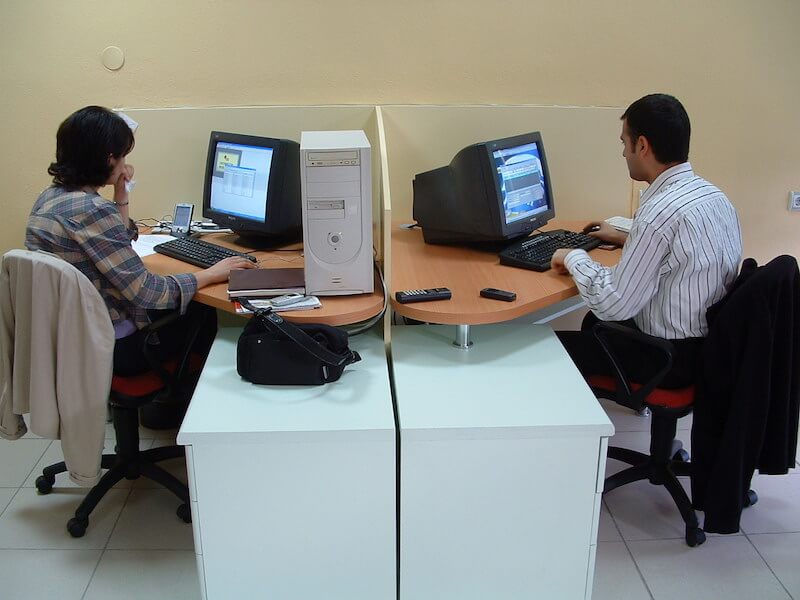Hotdesking is a big (or ‘hot’… sorry!) issue in social work currently. I haven’t heard a single social worker say anything good about it. I’m not talking about working in an open plan office. Plenty of professionals do this now. My own workspace at the Open University is open plan, and much complaining goes on about this. Personally, I like it. I like to see who’s in the office, and know who might be up for lunch. But then, I have my own quiet workspace at home three days a week.
Presumably from the local authority perspective, hotdesking is viewed as a cheap way of providing office space for many social workers. And possibly also seen as a way of encouraging people to mix within and across teams. I can’t think of any other incentive for it….
And it does indeed save space. In the large office where I’m observing, each team of around 10-12 people is two desks short. So that’s a saving of approximately 3 metres by 2.5 metres of desk and chair space per team. But the problem is that social workers often need to be in the office at the same time. On team meeting days for instance. On these days, only the earlybirds manage to get their own deskspace (so maybe hotdesking is a ploy to get people into the office early??). The desk shortage results in people wasting their time shifting their belongings around as they wait for a free space; for example, I witness one person perching on the end of a colleague’s desk until the latter leaves for a visit and frees up the desk.
The ‘desks’ are in fact just tables – there are no drawers. So when ‘my’ social worker (the one I’m shadowing) needs a stapler she has to walk across the room in search for one. Ditto a pair of scissors. Or a ruler. There is after all a limit to how much stuff you want to keep in your locker and haul out every day. A further waste of time.
One thing that seems to get forgotten is that people are territorial. This is significant when it comes to hotdesking. You know how if you park your car in the same carpark fairly frequently (at work, say, or the supermarket), you tend to park in the same area? Well, it’s the same with grabbing a desk. We have our favourite spot and tend to stick to it if it’s available. So hotdesking doesn’t really mix up teams as everyone sticks to their team’s area and to their one desk if they possibly can. What it does mean is that, every office day – and maybe even after every visit or meeting out of the office – social workers have to collect their belongings from a locker and set up their desk. Every single time. I watch one social worker go back and forth across the room from locker to desk a total of four times before she’s set up for the day.
The setting up of the computer alone takes a significant amount of time. Each social worker is provided with a laptop. These are generally small (for portability) so some workers connect to a larger monitor. Other people use a laptop riser to raise the screen. Surprisingly, no one has a dock so each day’s setting up involves plugging in a power cable, keyboard and mouse; then there’s the adjusting of the laptop position on the riser, or fiddling with the monitor screen till it’s at the right angle. This is all in addition to adjusting the height of the chair, and fetching tea/biscuits/pencil case/notebooks from a locker and positioning on today’s desk.
I wonder at times during the week if back and neck strain are common among social workers? I see people hunched over their laptop, peering at a small screen. Later I learn that the tallest person in the room (and he is very tall!) has his own adjusted desk. So there is one way of getting your own desk…. Needing a specific chair doesn’t cut it – these people have to locate ‘their’ chair each day and wheel it to that day’s desk. I don’t expect that the majority – people who aren’t particularly tall or short and who doesn’t need a specific chair – bother to adjust their chair height each day and check they are an arm’s length away from their screen. So surely hotdesking must be a health and safety issue?
Getting back to time-wasting, though, the biggest waste of time I observe is that people entering the room can’t immediately find the person they’re looking for. I hear all around me ‘where’s X?’ and ‘is Y in today?’ If an individual has no particular desk then they could be sitting anywhere in this large room (capacity of 50 plus). So if you want to locate someone you have to look around the room and then ask one of their colleagues. And of course that person might not know if X or Y are in another meeting room or out on a visit so there’s still a bit of wandering around looking to do. I suppose the exercise helps counter the effect of all the peering at screens while sitting on badly-adjusted chairs.

Comments
No comment